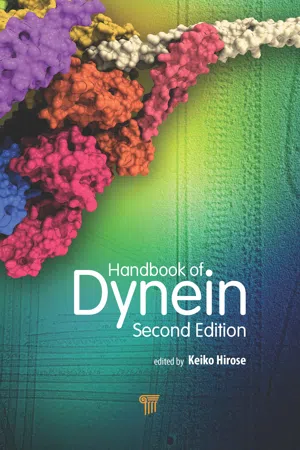
Handbook of Dynein (Second Edition)
Keiko Hirose, Keiko Hirose
- 420 Seiten
- English
- ePUB (handyfreundlich)
- Über iOS und Android verfügbar
Handbook of Dynein (Second Edition)
Keiko Hirose, Keiko Hirose
Über dieses Buch
Dyneins are molecular motors that are involved in various cellular processes, such as cilia and flagella motility, vesicular transport, and mitosis. Since the first edition of this book was published in 2012, there has been a significant breakthrough: the crystal structures of the motor domains of cytoplasmic dynein have been solved and the previously unknown details of this huge and complex molecule have been unveiled. This new edition contains 14 chapters written by researchers in the US, Europe, and Asia, including 3 new chapters that incorporate new fields. The other chapters have also been substantially updated. Compared with the earlier edition, this book focuses more on the motile mechanisms of dynein, especially by biophysical methods such as cryo-EM, X-ray crystallography, and single-molecule nanometry. It is a major handbook for frontline researchers as well as for advanced students studying cell biology, molecular biology, biochemistry, biophysics, and structural biology.
Häufig gestellte Fragen
Information
Chapter 1
Dyneins: Ancient Protein Complexes Gradually Reveal Their Secrets
1.1 Introduction

1.2 Dynein Molecular Structure Coming into View
1.2.1 Axonemal Arms



Inhaltsverzeichnis
- Cover
- Half Title
- Title Page
- Copyright Page
- Table of Contents
- Preface
- 1 Dyneins: Ancient Protein Complexes Gradually Reveal Their Secrets
- 2 Structural and Functional Analysis of the Dynein Motor Domain
- 3 Electron Microscopy Studies of Dynein: From Subdomains to Microtubule-Bound Assemblies
- 4 Subunit Architecture of the Cytoplasmic Dynein Tail
- 5 Measuring the Motile Properties of Single Dynein Molecules
- 6 Mechanics of Dynein Motility
- 7 Interactions of Multiple Dynein Motors Studied Using DNA Scaffolding
- 8 Cytoplasmic Dynein Force Regulation in vitro and in vivo
- 9 Dynein in Endosome and Phagosome Maturation
- 10 Dynein in Intraflagellar Transport
- 11 Diversity of Chlamydomonas Axonemal Dyneins
- 12 Motility of Axonemal Dyneins
- 13 Axonemal Dyneins in Cilia and Flagella
- 14 Regulatory Mechanism of Axonemal Dynein
- Index